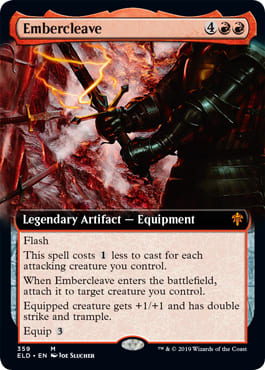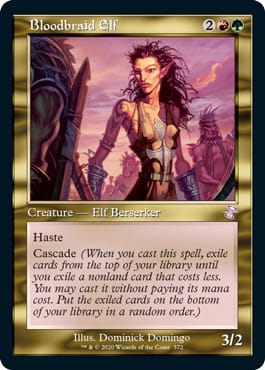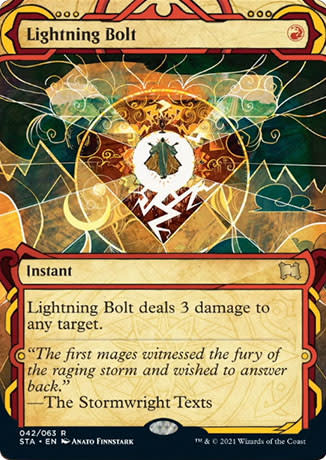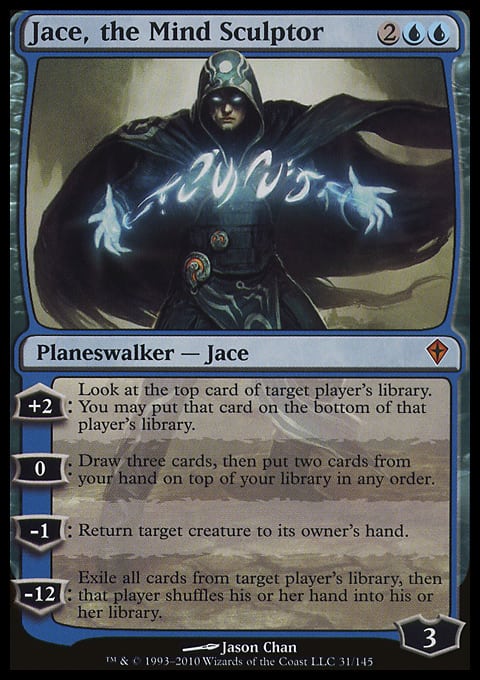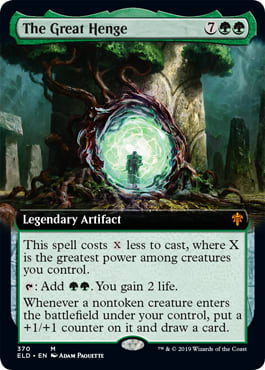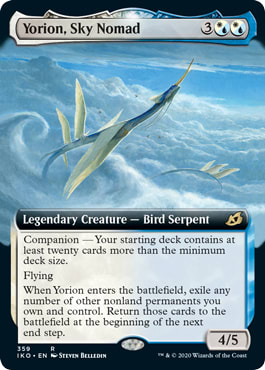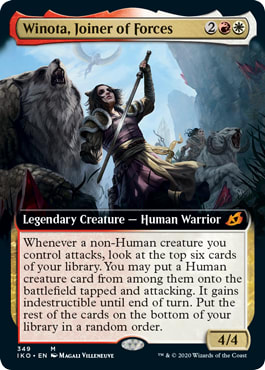The fall rotation is perhaps the most exciting time of the year in Standard. Not only do we get all the excitement of a brand-new big set, but we also get to say farewell to half the sets currently legal in the format. Sometimes it's sad to see super sweet cards go, but oftentimes they have been legal for what feels like forever and it's great to move on to something new.
This year's rotation falls into the latter camp, as Standard has been living under the shadow of Throne of Eldraine and friends for what feels like a decade now. Eldraine will probably go down in Magic history as one of the most powerful Standard sets ever, as not only is Standard currently buckling under the weight of its best cards, but it's easy to forget that there are currently six cards from Eldraine on the current ban list. That's right, that Eldraine card you hate losing to over and over again is at best the 7th best card in the set!
It's not just Eldraine of course, as Ikoria: Lair of Behemoths also has a number of whoppers that have been hammering Standard for what feels like forever as well.
We're still a little bit away from Innistrad: Midnight Hunt previews, but much of what is going to dictate new Standard is what happens when these powerful cards leave the format. Context is everything, and the context of these powerful Eldraine and Ikoria cards is one we've been existing under for a while now. Once they're gone, the base level rules of the format will change.
Did you know that when Jace, the Mind Sculptor was first released, it didn't really make much of an impact in Standard? Yes, that Jace, the one that was eventually banned in Standard and spent time banned in Modern as well. The reason was that two of the most played cards in the format were Bloodbraid Elf and Lightning Bolt, two cards that lined up exceptionally well against Jace. The context they created was hostile to Jace, so Jace wasn't able to thrive.
Today I want to look at the result of some of the biggest cards in Eldraine and Ikoria leaving the format, to help prepare us for the coming rotation as well as our evaluations of the new Innistrad set.
Embercleave: Blocking Is Unbanned!
If I had a dollar for every time I've said "As long as they don't have Embercleave we win" in the last few years I would be a very rich man.
Embercleave has the same endemic problem that many of the cards on this list have - It's a game ending card that almost completely invalidates the previous turns of the game, boiling everything down to a "do you have it or do you not" moment that often ends the game on the spot. Trying to block into a potential Embercleave is honestly a joke, forcing you to have interaction in your deck and available the turn your opponent can possibly cast it.
The removal of Embercleave from the format will change how aggressive decks operate, because they can no longer rely on one big card to just win the game by itself. Instead, we will likely see a shift back to more "normal" nickel and dime sorts of aggressive strategies, with a focus on attacking, blocking, and removal spells. Normal things like creature sizing and having the appropriate removal spells will matter, as will finding other ways to push damage through. Maul of the Skyclaves is a good example of a card that will be much more of a necessity.
Normal attacking and blocking will of course be possible once again because...
Lovestruck Beast: Attacking Is Unbanned!
Lovestruck Beast isn't nearly as flashy as many of the cards on this list, nor does it translate super well into other formats on raw rate. Regardless, it will likely go down as one of the best defensive Standard creatures of all time. As card advantage as well as a huge attacker, Lovestruck Beast has found its way into countless Standard decks in the last two years, but most impactful of all is how dramatically it has affected aggressive decks.
Lovestruck Beast put a soft ban on attacking creatures with only 1 toughness and basically any non-evasive attacking creature with less than 4 toughness. That is a huge spread of cards invalidated by a single card that's already excellent on rate, putting an immense amount of pressure on the format. There's a reason that basically every aggressive deck of the last two years was often centered around Embercleave or Winota, Joiner of Forces, because they just couldn't get through otherwise.
The exodus of Lovestruck Beast (as well as a few other cards on this list) is going to go a long way toward allowing us to play more normal aggressive Magic again.
Bonecrusher Giant: 2 toughness Isn't A Drawback Anymore!
Perhaps the best card on this entire list, Bonecrusher Giant operates under many of the same rules as Lovestruck Beast. An absolute killer of aggressive decks, a single Bonecrusher Giant played on curve on turn two and three was often enough to stymie most aggressive starts, once again making something that goes huge over the top like Embercleave or Winota a necessity to make up for the lost ground.
Stomp however is a much more specific restriction than the attacking and blocking stats of Lovestruck Beast, as there was essentially a soft ban on creatures with two or less toughness that weren't immediately impactful. Cards like Lotus Cobra, Sedgemoor Witch, Kargan Intimidator, and basically any card related to the party mechanic were all very hard to play in this Standard format, as you're just opening yourself up to the clean Bonecrusher Giant two for one. Losing a creature to a spot removal spell isn't great, but at least it's a one for one.
With Bonecrusher Giant out of the format, there's far less pressure on these sorts of creatures to have an immediate impact.
The Great Henge: The Creature Deck Won't Outdraw You Anymore!
It's a strange world when the Green-based creature deck has the best draw engine in the format, but that's just the world of Throne of Eldraine. The Great Henge is very similar to Embercleave in that it is a creature-based card that almost immediately invalidates all the game actions that came before it, but rather than ending the game in a single combat step it ends the game by being in play for two turns and allowing your opponent to draw eight extra cards and bury you.
Once The Great Henge resolves, all things that are traditionally good against creature decks (spot removal, good blockers, even mass removal) are rendered impotent if you can't win the game in a turn or two or directly answer The Great Henge. With it leaving the format, the rules change back to how Magic normally works: removal is good against creatures, keeping the creature decks in check and forcing them to find good ways to mitigate this. This will increase the creature deck's reliance on things like planeswalkers, as well as increasing the need for splashes for things like Negate or Duress to help answer sweepers.
Embercleave and The Great Henge made creature decks feel almost more like combo decks, with both of them leaving they will start to look like normal creature decks again.
Into The Story: The Tempo Deck No Longer Has The Best Card Draw Spell!
It's amusing that Rogues may be the most hated deck in Standard right now, despite being a deck that is rather novel. It's one of the format's few Lurrus of the Dream-Den decks, as well as the rare Standard deck that is full of almost entirely one and two mana spells. It's also a relatively cheap deck, with many of the key pieces being commons and uncommons.
However, people don't like getting milled and hate getting their spells countered while their opponent sits there with a full grip of cards.
The card that pushes Rogues past just being a cool tempo deck is Into the Story, which gives the deck an extremely powerful card draw engine to go along with its suite of cheap interaction and threats. Tempo decks don't typically get to draw cards en masse, usually leaning on card selection like Opt or Ponder to help try and find the right cards at the right time. Into the Story completely flipped the script, allowing Rogues the benefit of a good, cheap early game alongside raw late game draw power.
It is very unlikely that future tempo decks will have access to this sort of card draw going forward, making both synergy and having the right tools at the right time much more important. They're going to have to go back to using a scalpel to pick apart their opponents, rather than just having a sledgehammer.
Yorion, Sky Nomad: It's Not Extremely Easy To Gain Value Off A Free Card!
While Lurrus of the Dream-Den is clearly the most powerful companion (and probably in the discussion for top 10 cards of all time), it's not well suited for Standard. Yorion, Sky Nomad however is the perfect Standard card.
It is so comically easy to gain a huge advantage with Yorion in a game of Standard, because all it asks of you is to play cards that are mostly already good on their own. Much like how Edgewall Innkeeper is so good because the adventure creatures are some of the best cards in the format even absent of synergy, Yorion is the same way. Cards with enters the battlefield effects tend to be tournament staples regardless of anything else, so adding Yorion on top of that is a no-brainer.
Finding this sort of super easy value engine is not going to be nearly as simple after rotation. More traditional means of card advantage are going to have to be turned to, whether it is planeswalkers or other forms of card draw.
Emergent Ultimatum: Negate Or Duress Are No Longer Necessary!
Ugin, the Spirit Dragon is a card that could very easily have made it onto this list, but has been pushed out of the format by Emergent Ultimatum. Either way, both cards have a very similar play pattern: get to 7 (or 8) mana, cast your card that invalidates everything else that has happened in the game, and then win the game.
When cards like Emergent Ultimatum or Ugin are in the format, there's a ton of pressure to either win the game very quickly or have some sort of direct way of interacting with them, which is usually only found in Blue or Black. Without the ability to prevent them from being cast with either a counterspell or targeted discard, it's too difficult to get any other sort of end game online because of how hard they get trumped.
With these sorts of effects out of the format (Yorion also falls under this umbrella as a huge endgame card), decks with a wider variety of endgames have more room to breathe. Decks like Mono Red Control or Mono White Control, which can be really fun Standard decks that aren't traditional in the sense that they play counterspells, have the ability to play a longer game without getting clowned by one card.
Assuming no card enters to take the place of these ultimate one card endgames, this should open up things a lot for the slower decks in the format.
Winota, Joiner of Forces: You No Longer Need To Have Removal Or Die On Turn Four!
It has only recently come back in vogue thanks to some new printings that helped fill the holes in the deck, but there's no doubt that Winota, Joiner of Forces has been one of the most powerful cards in Standard since it was printed, even if it can be challenging to use at times.
Winota operates in a space that feels more akin to Modern deck than a Standard deck, and if left unimpeded can easily win the game (or at least create an insurmountable advantage) as early as turn three. Just like in Modern, you are either required to have a direct answer to your opponent's powerful linear deck or just go faster yourself. Because going faster in Standard isn't really feasible, this simply means that it's "have it or die" against Winota decks. This puts a lot of pressure on decks to have the right kinds of removal at the right time, which is a pretty big deck-building restriction.
Cards like Winota don't come around that often, so as she leaves this soft requirement of having removal leaves as well. Less pressure on deck-building means that deck-building can be more open and fluid.
Context Is Everything
Helping to solve these questions and figure out the important rules of a format is extremely important if you want to get a handle on how to build and play your decks properly in it. Every single new card that is printed is going to be bound by the context of the new format, so figuring out the rules of the new format as quickly as possible is huge.
I don't know about y'all, but I can't wait for the rules of Standard to change!
















